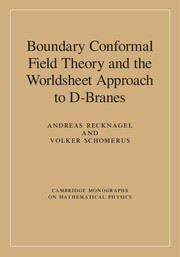Book contents
- Frontmatter
- Dedication
- Contents
- Introduction
- 1 Free field theory with boundaries
- 2 Superstrings and branes
- 3 Conformal field theory on the plane
- 4 Boundary conformal field theory
- 5 Perturbations of boundary conformal field theories
- 6 The Wess–Zumino–Witten model on SU(2)
- 7 Gepner model boundary states and Calabi–Yau branes
- Appendix
- References
- Index
7 - Gepner model boundary states and Calabi–Yau branes
Published online by Cambridge University Press: 05 November 2013
- Frontmatter
- Dedication
- Contents
- Introduction
- 1 Free field theory with boundaries
- 2 Superstrings and branes
- 3 Conformal field theory on the plane
- 4 Boundary conformal field theory
- 5 Perturbations of boundary conformal field theories
- 6 The Wess–Zumino–Witten model on SU(2)
- 7 Gepner model boundary states and Calabi–Yau branes
- Appendix
- References
- Index
Summary
In this chapter, we apply some of the general methods outlined in earlier chapters to a class of conformal field theories (CFTs) which are of particular interest for string theory: Gepner models [228] provide an algebraic formulation of super-string compactifications from ten to lower dimensions, formulated in terms of rational “internal” CFTs. Gepner models are considered to be the most relevant perturbative string vacua as far as phenomenology is concerned. It has turned out that they are closely connected to σ-model compactifications on Calabi–Yau manifolds and that many properties can be studied equally well in this geometric setting. The Gepner model description is more appropriate in the stringy regime, while the Calabi–Yau picture can be associated with the large-volume regime. While many (not all) correlation functions may receive corrections when varying Kähler moduli to pass from one regime to another, some aspects (such as the number and type of fields in the effective low-energy theory) do not change, due to the high amount of spacetime supersymmetry: N = 2 for a closed string compactification to four dimensions. A brane, on the other hand, breaks at least half of the supersymmetry, and thus it may well be that the low-energy physics of the geometric regime differs from the one obtained at stringy distances. Therefore, it is clearly of some interest to study D-branes in the exact CFT framework of Gepner models.
- Type
- Chapter
- Information
- Publisher: Cambridge University PressPrint publication year: 2013



